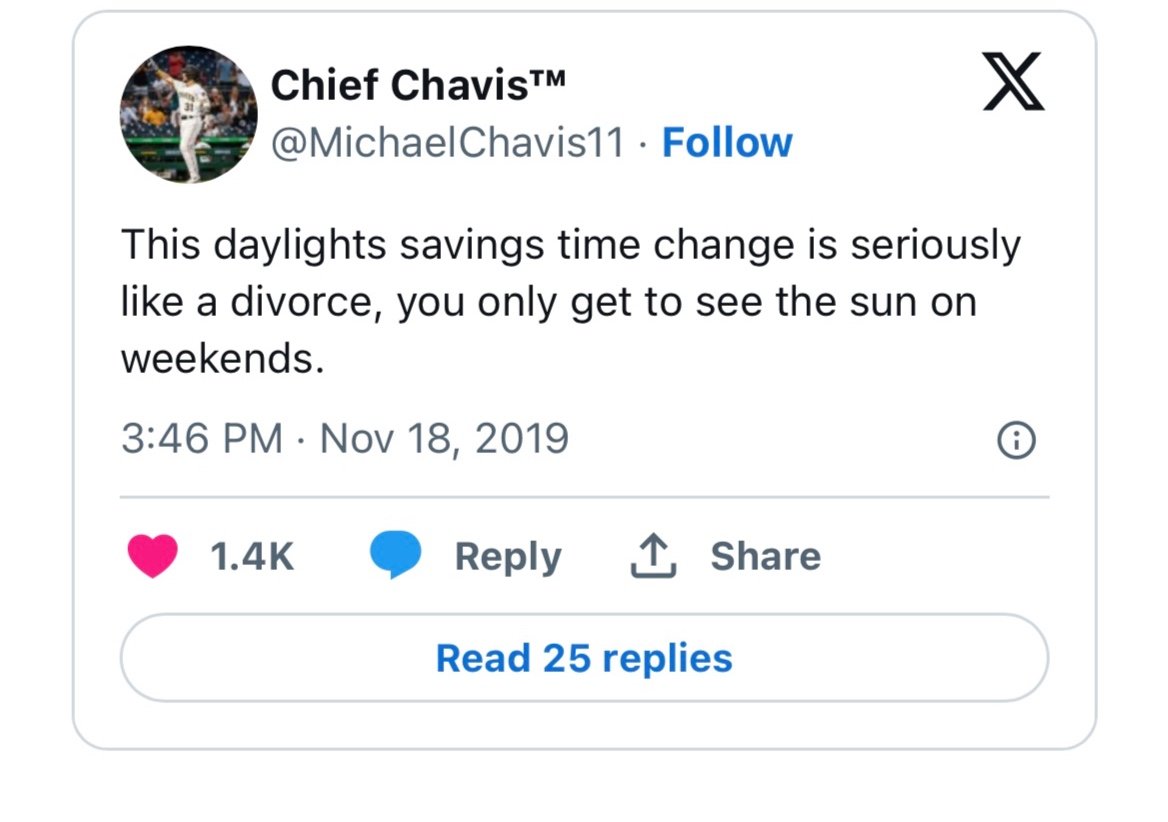Let’s Abolish Daylight Savings Time Already!
A Brief History of Daylight Savings Time
The Earth's axis of rotation and orbital axis are not precisely aligned. This 23.5 degree difference in axes is termed 'axis tilt' and results in seasonal differences and variable durations of daylight over the course of the year. Axis tilt also results in numerous timekeeping errors, billions of dollars in lost productivity, and even deaths.
As early as the 18th century, it was thought that adjusting the clocks could save energy & money. Benjamin Franklin observed that the same people who slept in the mornings, burned candled for light at night. He satirically proposed a tax on window shades and advocated the firing of cannons at dawn to awaken late sleepers. Notably, the Franklin Institute insists that that Franklin should not be credited with - or blamed for - for the invention of DST.
In 1895 George Hudson, a New Zealand entomologist and astronomer, proposed that clocks could be adjusted seasonally to better align with the daylight hours. Because the effect of axis tilt on day length is most pronounced at higher latitudes, the concept of time shifting was particularly appealing in countries like Great Britain, where the idea was termed Daylight Savings Time (DST) and was proposed by the English Royal Astronomical Society. At the time, Scientific American raved about the advantages of the proposed change:
“It is not often that a measure of such a startling character as the Daylight Saving Bill is introduced into the English House of Commons. The fact that the momentous changes advocated are proposed by William Willett, a member of the Royal Astronomical Society, suggests that the measure may not be so chimerical as might be supposed. It is proposed during part of the spring and autumn, and the whole of the summer, to advance the clocks throughout the country, with a view to including within the working hours a longer stretch of daylight. Among the commercial advantages are that large users of gas and other artificial light would realize a saving of $15,000,000. To the average individual, however, the most attractive feature of the proposed change is that it would afford a longer stretch of daylight for recreation.”
—Scientific American, August 1908
Almost all of these bold predictions would ultimately turn out to be false.
The US was initially skeptical about clock changes, but WW1 convinced some of the economic necessity of daylight savings. Daylight savings time was implemented in the United States on March 19, 1918, when the Standard Time Act was signed into law. The goal was to add daylight hours into the day to reduce energy costs during the first world war.
It is unclear what effect - if any - this first trial of DST had in America. It was only in effect for a year and a half, as it was repealed after the armistice that ended WWI.
Two decades later, in February 1942, congress reimplemented DST with the US involvement in WW2, hoping to increase war production and decrease domestic energy use. The daylight savings time zones were even referred to as Eastern War Time, Pacific War Time, etc.
“Get Your Hoe Ready!” for Daylight Savings Time
Again, in 1945 when the war ended, the National Daylight Time Act was repealed. On a state by state basis, DST continued ad hoc for the next two decades until 1966 when congress passed the Uniform Time Act, which established DST in all 50 states. While states can opt out of DST, only Hawaii and Arizona do so. Thus, for the last 60 years, daylight savings has become the de facto standard in the US.
Though well intended, there are major drawbacks to DST.
Heart attacks increase during DST transitions
A 2019 meta-analysis of 7 studies that together enrolled over 115,000 people, found that the transition to DST was associated with a small but significant increase in acute myocardial infarctions (AMI), particularly after the spring transition (OR: 1.05; 95% CI 1.02–1.07). Though a modest effect statistically, AMI is the leading cause of death in the US, accounting for over 1 million deaths annually, so the number of yearly deaths attributable to DST transitions could easily be in the 10s of thousands.
More accidents & Injuries after the Spring DST Transition
Barnes & Wagner analyzed a Bureau of Labor Statistics database and found that on the Monday following the spring DST transition, workers reported 40 minutes less sleep on average. They also examined a National Institute for Occupational Safety and Health database of mining injuries spanning 1983–2006 and found that miners were both more likely to be injured the Monday after the spring DST transition and that their injuries were more likely to be serious.
Not only does lack of sleep increase the potential for self injuries at work, it can also predispose fatigued workers to injure others:
Medical errors increase during DST
In 2021 researchers at the Mayo Clinic analyzed the frequency of self-reported safety related incidents (SRIs, a.k.a. medical errors) following DST transitions over an 8 year period (2010-2017). In the 7 days following the spring DST transition, there was an 8.8% increase in the rate of medical errors compared to the week before, and a highly significant 18.7% increase in human errors during that time. Interestingly, the fall DST transition was also associated with a small (4.2%) increase in medical errors, possibly due to impact on night shift employees.
Car and pedestrian accidents increase during DST
A 1996 study in the New England Journal of Medicine found a significant increase in the rate of motor vehicle accidents in Canada following the annual Spring DST transition. The relative risk was surprisingly large: 1.086 (95% CI 1.029 to 1.145) suggesting that a large number of motor vehicle accidents could be prevented by abandoning the annual “spring forward.”
Additional studies have also found that the spring DST transition leads to an increase in fatal motor vehicle accidents, with an estimated 627 excess - and potentially preventible - deaths in the United States between 1996 and 2017.
Interestingly, fall DST also increases the risk of vehicle-related fatalities, perhaps to an even greater extent than the spring. A 1999 analysis found that fall DST transitions were associated with an excess of approximately 171 pedestrian and 195 motorist deaths each year, possibly due to earlier sunsets - and hence reduced visibility - during peak evening outdoor travel hours.
DST actually increases energy consumption
Despite the putative purpose of DST being energy conservation, recent studies suggest that DST is actually associated with increased energy consumption.
The authors took advantage of a natural experiment in Indiana up until 2006 whereby 77 counties observed Eastern Standard Time (EST) without DST; 10 counties observed Central Standard Time (CST) with DST; and 5 counties observed EST with DST. This meant that adjacent counties in the same state were sometimes on the same schedule and sometimes 1 hour apart. Because the whole state switched to DST in 2006, the researchers could compare data across counties before and after the transition.
The found that household energy consumption increased by 61.01 kWh/year, which translates to a ~1% increase. Statewide this is estimated to add $8.9m per year in electricity costs and produce 188,490 tons of carbon dioxide.
So why not get rid of DST?
We tried. At least four times!
Between WW1 and beginning of WW2 there was no DST. Between the end of WW2 and the passage of the Uniform Time Act of 1966 there was no national DST, though DST did exist on a state by state basis.
Additionally, in 1973 DST time changes were (briefly) abolished, which turned out to be an utter disaster. In December 1973, in an attempt to address the oil crisis (and correctly recognizing that DST actually increased energy use), congress passed the Emergency Daylight Savings Time Energy Conservation Act, which maintained DST year round. Abolishing biannual time changes did appear to have the desired effect of reducing energy consumption nationally by roughly 0.4 to 1.5%. Despite initial support, however, the Act soon became wildly unpopular, with support falling from 79% of Americans upon approval to 42% after just 8 months. Major concerns based on anecdotal reports of pedestrian and vehicular accidents in the dark morning hours swayed public sentiment. Initially intended as a 2 year trial period, the law was repealed in less than one year on September 30, 1974 after a 383‐to‐16 vote in the house and a unanimous vote in the senate.
Currently, most Americans (as many as 70% in some polls) want to do away with DST. In 2022, the congress tried to abolish the annual time switch, again by going to year-round DST. This bill was opposed by sleep medicine physicians, who argued that circadian rhythms would be more naturally aligned with standard time.
Why does the American Academy of Sleep Medicine favors the adoption of permanent standard time instead of permanent daylight savings time?
Abolishing the biannual time changes clearly fixes some problems; as we have seen "falling back" and "springing forward" are likely associated with increased occupational, medical, pedestrian, and vehicular accidents. But which approach is better: permanent DST or permanent standard time? To understand why, we need to understand the Western Edge effect of timezones.
The Western Edge effect of timezones
There is a discontinuity in the sleep-daylight cycles at the edges of timezones. A recent study found that these discontinuities were associated with a reduction in sleep - 19 minutes less on average for people living in the extreme western side of a timezone - and that this had significant economic and health consequences: individuals in the Westernmost counties were 11 percent more likely to be overweight and 21 percent more likely to be obese, with a corresponding increase in the incidence of diabetes and cardiovascular disease. There was even a noted increase in the risk of breast cancer in counties at the wester extreme of each time zone, likely related to both increased adiposity and reduced physical activity as risk factors for tumerogenesis. Daylight differences even impacted wages, which were 3% lower on the late sunrise / late subset side of the zone border, possibly related to subtle differences in duration of sleep and health status.
Effect of daylight on bedtime by county in the US. People who live on the Western edge of the county have later bedtimes, resulting less sleep and associated with worse health outcomes.
Comparison of Permanent DST and Permanent Standard Time
| Permanent DST | Permanent Standard Time | |
|---|---|---|
| Noon approximates solar noon: | No | Yes |
| Mornings: | Darker | More sunlight |
| Evenings: | More sunlight | Darker |
| Energy costs: | Higher | Lower |
| Health effects: | May have worse outcomes in terms of obesity, diabetes, and cardiovascular disease due to the Western Edge effect. | Less likely to have adverse health effects. |
| Prior attempts: | Failed in 1973 | Successfully implemented in Mexico in 2022 |
| Rationale: | Better for the petro-chemical industry (more energy usage) Better for candy manufacturers (more daylight on Halloween) Better for golf & tenis club owners (more afternoon hours of sunlight) Better for barbecue industry | Better for kids (fewer days where school starts in darkness) Better for baseball owners (night games have higher attendance!) |
Why haven’t we switched to permanent standard time?
Most of the world has wisely abandoned DST or even more wisely never adopted it in the first place!
So why do we cling to DST in Europe and North America? Cui bueno? Extra daylight means extra time to spend money. Perhaps the biggest opponent to changing DST is the petrochemical industry! More hours of daylight means more trips to parks, shops, and other destinations, translating into more gasoline sales. When daylight savings was extended by a month in 1986, it is estimated that there was $1b in additional gasoline sales.
An unlikely alliance of groups have successfully lobbied to prevent a change to year round DST: Among these groups are candy manufacturers (more Halloween candy is sold if there is more daylight), the gardening industry, the barbecue industry, as well as owners of golf clubs, tennis courts, etc. Paradoxically night games are great for our national pastime: baseball. Attendance is higher at night!, though the players really hate it:
Bottom Line:
Benjamin Franklin wrote that “Early to bed and early to rise makes a man healthy, wealthy, and wise.” If Franklin were alive today, he’d likely disclaim Daylight Savings Time as it is demonstrably bad for our health, wealth, and environment.







